Estimated reading time: 26 minutes
It’s hard to imagine how something as basic as a tree could save a life, but there are nutritional and medicinal aspects of trees that can make a real difference. This is especially true in desperate times when society has collapsed and we’re all confronted with the end of the world as we know it.
It’s a time when grocery stores are a thing of the past, pharmacies are shuttered and even basic medical care is out of reach. When every resource is stretched thin the best survival solutions will be found in the pursuit of alternatives to satisfy the most basic needs. Trees represent one of those alternative paths and some of their benefits may surprise you.
Want to save this post for later? Click Here to Pin It On Pinterest!
Tree Benefits Defined
Both nutritional and medicinal benefits from trees are found in the wood, bark, sap, roots, leaves, flower, fruits and seeds. The point is, you have to consider the whole tree to derive the best benefits, and if you know what to harvest and how to process it you can not only keep yourself fed but cure a range of ailments.
We’ll cover specific trees and what to harvest and how to prepare that harvest for food and medicine. For the most part we’re going to cover “wild” trees. There are hundreds of domesticated fruit trees from apples to oranges that are usually planted in yards or orchards, and while they all offer benefits those benefits are obvious. Our goal is to go beyond the obvious.
We’ll also explore some dangerous trees as well. If there’s one fundamental truth about wild foraging, it’s that the majority of plants in nature are toxic if not poisonous. Trees are no exception so you need to know exactly what to look for and what to avoid.
Trees as a Food Source
When we think of food from trees our first thoughts go to fruits and nuts. The only problem with that harvest is that fruits and nuts are highly seasonal. When you look beyond the obvious, trees can become a source of nutrition and medicines year-round.
From a food standpoint, the bark, leaves and flowers and even the sap of many trees offer additional nutritional benefits beyond fruits and nuts. If a tree is bearing fruit or the nuts have matured, you’re in luck. But sometimes you have to create your own luck and here are some basics about what to harvest from trees in addition to fruits and nuts.
Bark
This isn’t about harvesting the outer bark of trees for food or medicine. It’s about shaving the outer bark to get to the inner cambium layer of bark. Here’s a cross-section to give you an idea of how to find it:

The thin cambium inner bark is the circulatory system for a tree. It’s the membrane that transfers water and nutrients from the ground and also circulates glucose from the leaves made by photosynthesis to the rest of the tree.
As a result, the cambium layer is saturated with nutrients and chemical compounds that ultimately provide food and medicinal value.
Leaves
The leaves of many trees have micronutrients and bioflavonoids on a par with spinach, kale and other green, leafy vegetables. The young, emerging leaves are often used in a salad of mixed greens and dried tree leaves are the basis for many decoctions and medicinal teas.
Cultures around the world have used leaves to wrap and cook food deriving added nutrition from the leaf wrappers, while successfully cooking with primitive cooking techniques.
Flowers
Many of the flowers from trees are edible although most are used as a garnish on other foods. The primary benefit of most tree flowers is medicinal once again prepared as a decoction or tea and as a poultice for swelling and inflammation.
Roots
Tree roots share the same characteristics as the cambium inner-bark in the sense that they are saturated with nutrients. In most instances the outer layer of the roots are shaved to harvest the nutrients. The ability to find nutrition and medicines in tree roots offer the same all-season advantages that bark provides especially in winter.
Fruits
This is the obvious source of nutritional and medicinal benefits from a tree but even though fruiting is seasonal there are some interesting possibilities. Many fruits linger on the branch of a tree into winter. Some crabapple trees present this lingering fruit in addition to others. As a result, you have the opportunity to harvest frozen, fruit treats well into winter and early spring from the previous year.
The primary benefit of tree fruits is the high amount of vitamins particularly vitamin-C. One challenge is finding fruiting trees in the wild although crabapples and wild plum trees are more common than you would think, and mulberry trees are a champ due to their relatively long fruiting seasons (up to 4 weeks).
Nuts
The nuts from trees are a nutritional goldmine. Many are not only high in protein but also high in calories. A constant challenge with wild foraging is finding wild plants that provide sufficient calories but nuts never fail us when it comes to calories. Another benefit of nuts from trees is that many of the calories are calories from fat. That sounds like something we would want to avoid but in winter it’s the calories from fat that generate the most amount of internal body heat.
And speaking of winter, that’s another benefit of tree nuts for nutrition. Wild foraging in winter is a significant challenge, but nuts both on the tree and on the ground can provide enough nutrition and calories to sustain your survival.
The one downside to tree nuts is that most require some degree of processing. Unlike leaves and fruits that can be eaten right off the tree, nuts can be high maintenance. Some acorns are high in tannic acid and have to be soaked or boiled before being eaten.
Black walnuts have to be shelled and then cracked open to release the nut meat inside. If you’ve ever tried to crack a black walnut you understand the phrase, “A tough nut to crack.”
Wood
This isn’t just about wood for a fire or a shelter; you can eat the young, tender shoots of some trees. Some need to be boiled while others you can eat right off the tree.
The 18 Trees
We’re going to cover the basic nutritional and medicinal values of these trees, and also offer links to other articles and information about how to harvest the best parts, process them, and turn them into either food or medicines. In addition, there will be links to tree identification and then we’ll cover some dangerous trees to avoid.
1. Willow

The primary benefit of the Willow tree is medicinal. All willows contain a chemical compound known as salicin. Salicin is the primary, active ingredient in aspirin and the salicin from the inner (cambium) bark of willow trees is still used in many countries to manufacture aspirin.
The White Willow is considered the best species of willow for aspirin due to its high concentrations of salicin. The medicinal treatment is usually made as an infusion of the bark into a tea to treat pain.
2. Pines (Conifers)

Pines have a surprising range of benefits both nutritional and medicinal. The pine needles are used to make a pine needle tea that is both high in Vitamin-C but other vitamins as well. Pine needles are also used to make a pine needle soda that has a lemon/lime flavor profile.
The inner bark (cambium again) is used to make everything from tea to pine bark flour to a pasta substitute when cut into long strips and boiled.
The pine cones are an excellent source of pine nuts particularly the Pinyon pine which grows predominantly on the west coast of North America. Young, immature pine cones can also be made into a pine cone jelly.
3. Oak
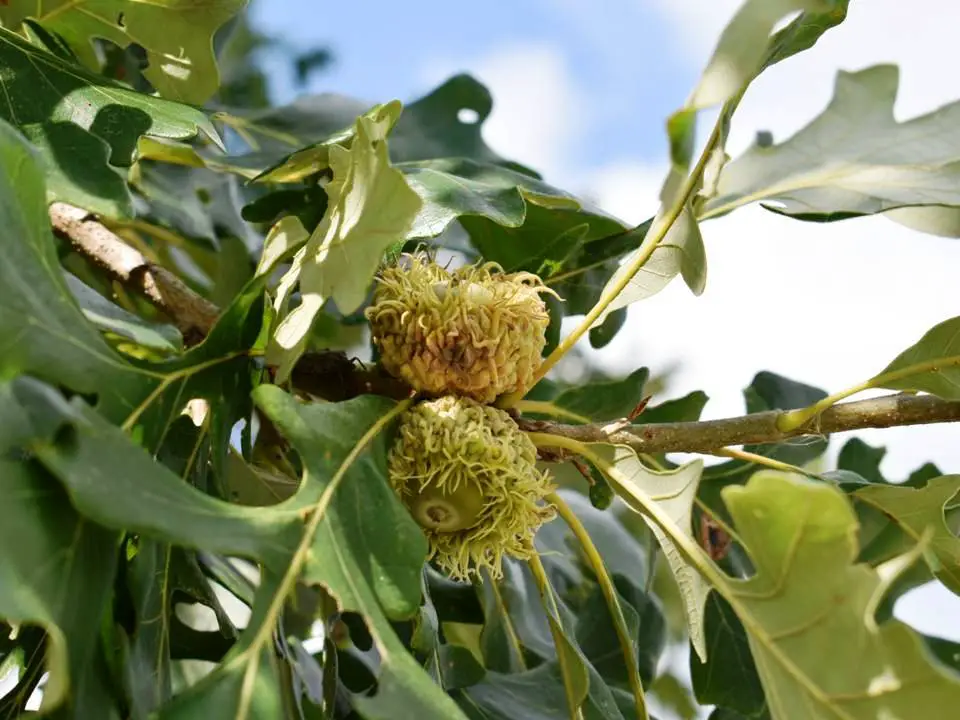
The primary benefits of oak come from the acorns. They are an excellent source of calories and while they have some degree of protein, other nuts like black walnut, pine nuts and chestnuts have more protein ounce for ounce.
Acorns can be consumed a variety of ways. The acorns can be ground into a flour or roasted and eaten as a snack. But a word of caution: acorns have high concentrations of tannins also known as tannic acid. In almost all instances, acorns must be soaked in water to leach out the tannins.
Cold water can be used with multiple rinses and changes, or they can be boiled with a few changes as well. The key is to look for clear, running water from the acorns. Usually the leaching water will turn red but when it runs clear, the tannins are gone.
On a plus side, the tannins from acorns can be used to help pull together the edges of a wound. Better yet, tannins have both antiviral and antiseptic properties.
Even the leaves of an oak tree are edible, but make sure you pick them when they are young and tender. They can be eaten in a soup or salad.
4. Maple

Maple trees are primarily known for their sap which can be boiled down to a syrup although the sap itself can drunk as an emergency water supply with a lightly sweet flavor.
The young, tender leaves can also be eaten in soups or salads and can even be breaded and fried. Fried maple leaves are considered a delicacy in Japan and are often dipped into a tempura batter and deep fried.
The inner cambium bark can be eaten raw or added to any cooked dish and even the nuts can be harvested from their helicopter wing seed casings and roasted or boiled.
5. Black Walnut
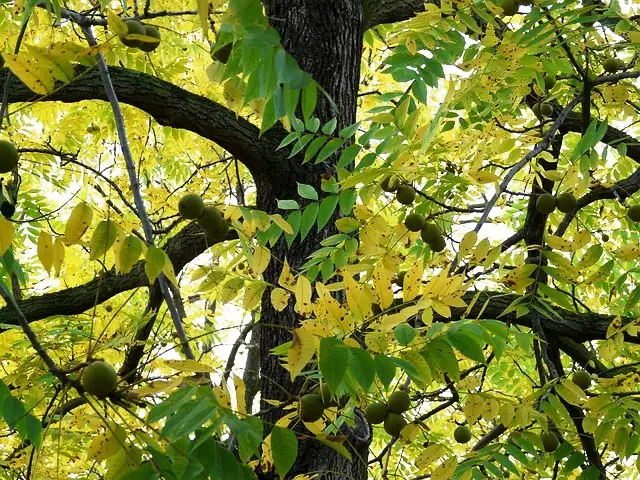
The primary nutritional benefit of the Black Walnut comes from it nuts. The nuts are very high in protein and a range of other nutrients and an excellent source of calories. The process for harvesting and processing the nuts is somewhat time-consuming but the nutritional value is worth the effort.
The sap can also be tapped and boiled down and makes a rich and sweet tasting syrup.
6. Gingko Bilboa
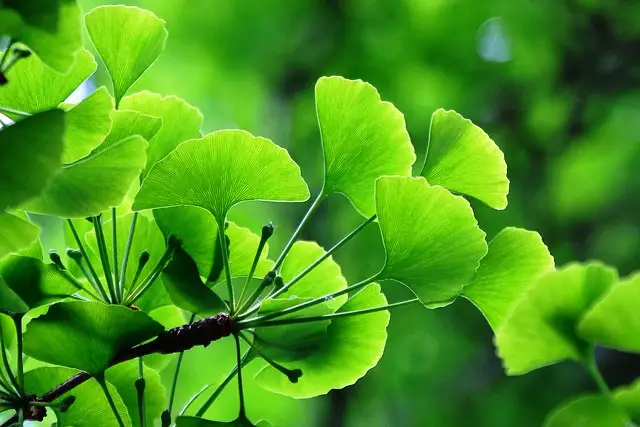
The Gingko is an ancient tree. In fact, it is the oldest deciduous trees on Earth. It has remarkable medicinal properties and many commercial products are sold using Gingko extracts in herbal supplements. This extract is derived from the dried leaves. It should be noted that the seeds of the Gingko tree are highly toxic.
Gingko has been used for centuries to treat memory issues, blood disorders and is still used today to keep memory sharp. Clinical studies indicate that gingko can improve circulation by opening blood vessels and even making the blood less sticky. Like many other medicinal plants it is an antioxidant.
Studies suggest that ginkgo may help people with Alzheimer disease:
- Improve thinking, learning, and memory (cognitive function)
- Have an easier time performing daily activities
- Improve social behavior
- Have fewer feelings of depression
Several studies have found that ginkgo may work as well as some prescription Alzheimer disease medications to delay the symptoms of dementia.
Gingko can be taken as capsules, tablets, tinctures, and as a dried leaf for teas.
7. Mulberry
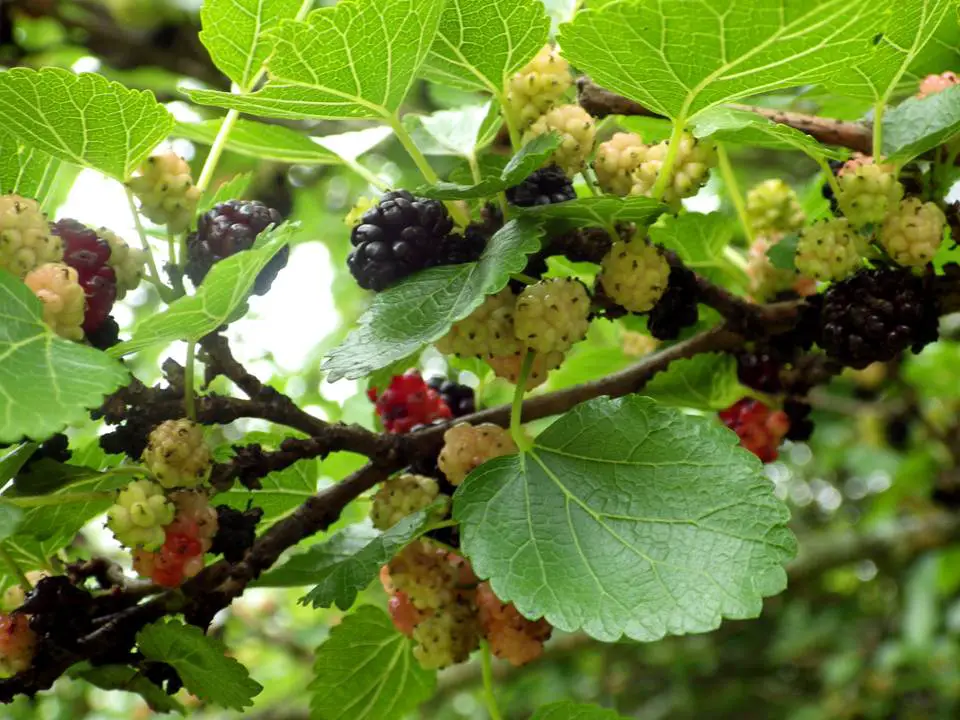
Mulberry trees should be considered a super fruit tree. They produce mulberries for up to a month or more and the quantity of mulberries from a single tree exceeds an acre of berry bushes. The mulberries are high in Vitamin-C and calories from the natural fructose sugars. The berries can be eaten out of hand, juiced or turned into jams or syrup.
The leaves of a mulberry are also edible but should be boiled first and can then be eaten like boiled spinach. They can also be stuffed or the dried leaves can be used to make a tea.
8. Sweetgum
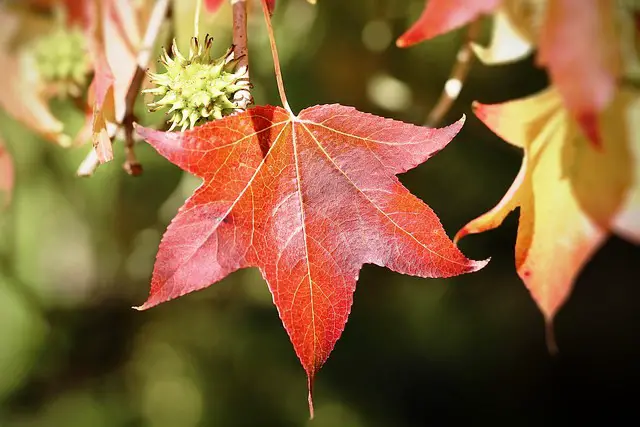
The Sweetgum tree has remarkable properties. In fact it has at times been referred to as a pharmacy in the field. Much of the Sweetgum contains something called shikimic acid which is actually used today to manufacture the anti-influenza drug “Oseltamivir.” This acid is mostly found in the leaves, inner bark or cambium layer and the seeds. The sap is resinous and also has medicinal properties.
The sap, known as storax, has been used for centuries to treat common ailments such as skin problems, coughs, and ulcers. More recently, storax has proven to be a strong antimicrobial agent even against multidrug resistant bacteria such as methicillin-resistant Staphylococcus aureus.
Other extracts derived from sweetgum trees have shown potential as antioxidants, anti-inflammatory agents, and chemopreventive agents. The compounds found in the extracts derived from sweetgum sap suppress hypertension in mice. Extracts from sweetgum seeds have anticonvulsant effects, which may make them suitable in the treatment of epilepsy.
In addition to the potential medicinal uses of sweetgum extracts, the extracts of the sap possess antifungal activity against various phytopathogenic fungi and have been effective treatments for reducing nematodes and the yellow mosquito, Aedes aegypti, populations thus highlighting the potential of these extracts as environment-friendly pesticides and antifungal agents.
9. Crab Apple
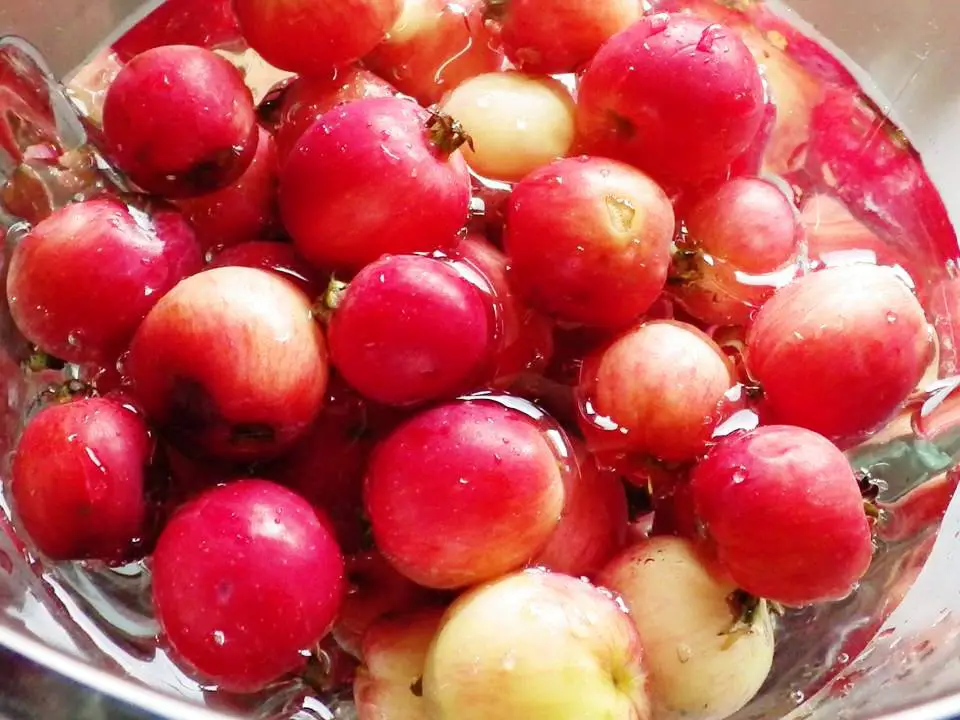
Crabapple trees are in fact wild apples although they often appear as ornamental trees in yards and gardens. Their nutritional value is on a par with domesticated apples you find in grocery stores although wild crabs have a more concentrated flavor and nutrients.
They are often used in jams and jellies and can be juiced, dried or eaten right off the tree. Some varieties have smaller fruits but all are edible.
Crabapple fruits are a good source of malic and tartaric acid. These acids, which lend the fruit its sour flavor, are responsible for the apple’s healing reputation. Crabapple fruits have been used for gout, indigestion, inflammation, constipation, and fever.
10. Tulip Tree
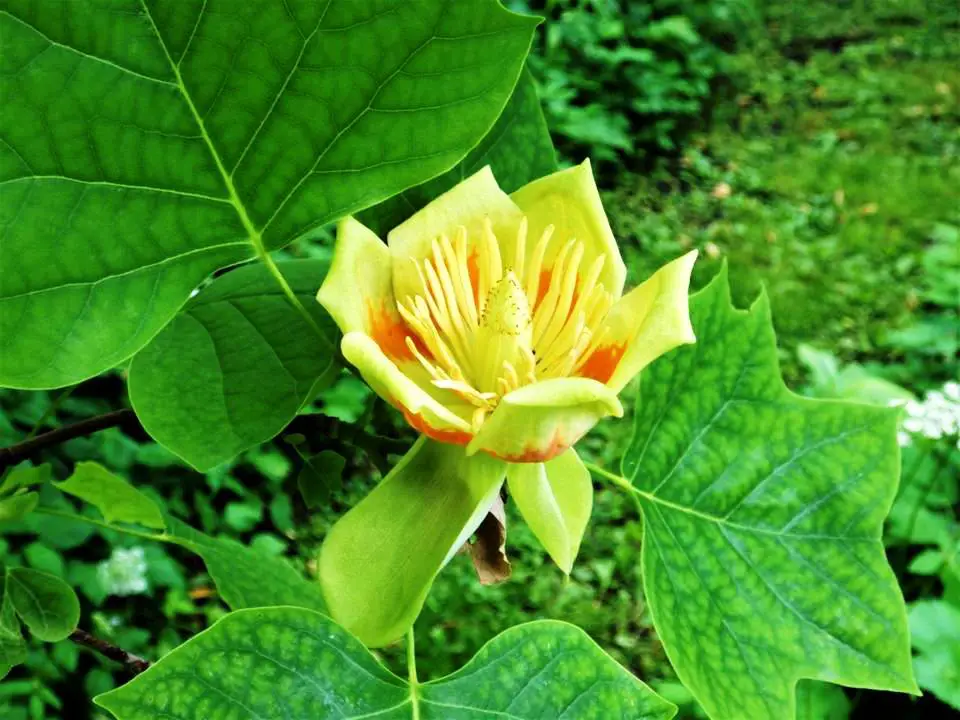
The Tulip tree is a member of the Poplar family of trees. It presents a range of medicinal benefits. The intensely acrid bitter inner bark, especially of the roots, is used domestically as a diuretic, tonic and stimulant. The raw green bark is also chewed as an aphrodisiac. The bark contains “tulipiferine”, which is said to exert powerful effects on the heart and nervous system.
A tea is used in the treatment of indigestion, dysentery, rheumatism, coughs, fevers etc. Externally, the tea is used as a wash and a poultice on wounds and boils. The root bark and the seeds have both been used to expel worms from the body.
11. Witch Hazel Tree
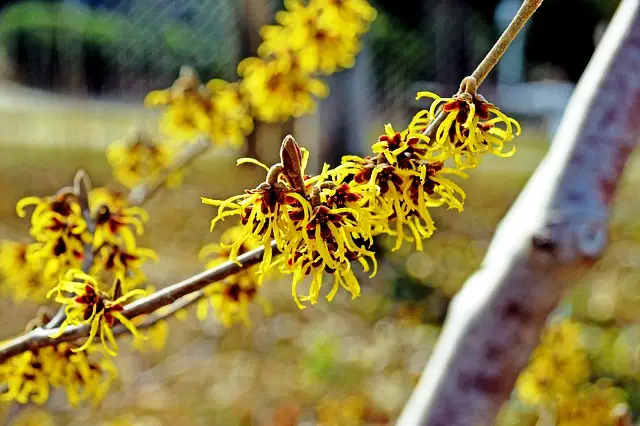
The Witch Hazel tree offers significant medicinal benefits. The astringent extract collected from its leaves and bark is said to ease inflammation and soothe sensitive skin.
The Witch Hazel tree has been used as an antiseptic, anti-inflammatory, hemostatic and tonic. It has been used internally by some cultures to treat hemorrhages from the bowels, uterus and lungs. Topically, it has been used to treat varicose veins, bruises, hemorrhoids and sprains.
12. Dogwood
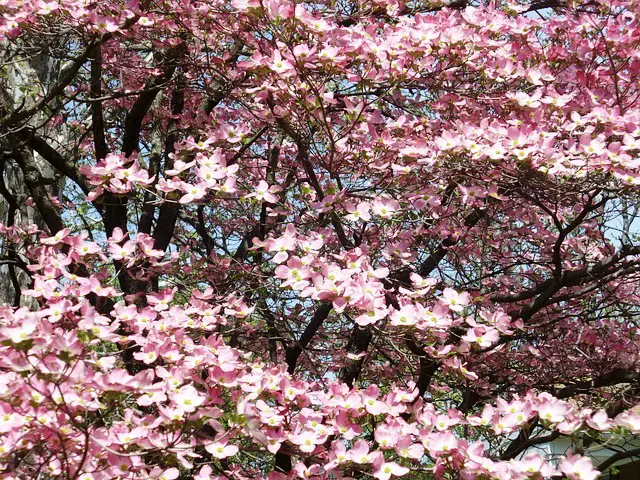
The Dogwood tree has numerous medicinal and nutritional benefits although it has primarily been planted as an ornamental. In the past, the Dogwood bark was highly valued as a treatment for malaria. Its inner bark emerged as an alternative for the very expensive and often diluted Jesuit’s bark and Peruvian bark. In fact, Dogwood bark was often substituted for the very expensive Jesuit’s bark in the treatment of malarial fevers.
Traditionally, a tincture of the Dogwood’s powdered bark was used as an antiseptic and tonic. The bark was usually cured for year to tempter the harshness of the fresh bark which was shown to irritate the bowels and lining of the stomach.
It was during the Civil War that the Confederate army used Dogwood as a treatment for wounds, illness and an assortment of other ailments due to the lack of other treatments and medicines at that time.
13. Beech Tree
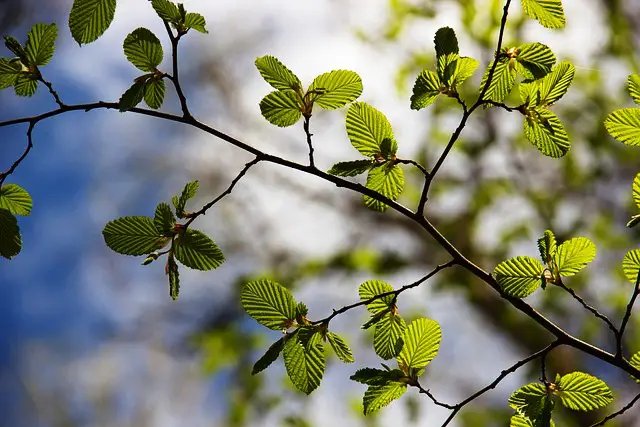
There are numerous varieties of Beech trees including the American Beech, the European Beech and the Japanese Beech. All leaves are edible when fresh picked. They are often enjoyed in salads on their own or mixed with other greens. They’re typically only edible in spring when the tender leaves first emerge.
The mature leaves have medicinal value for treatment both the nerves and stomach ailments. A tonic was often made from Beech leaves to stimulate the appetite and cleanse the digestive system. The American Beech variety was also used to create medications to treat diabetic conditions, chapped lips and gum pain.
The small, edible nuts are very tasty but not that well known. The inner bark, after drying and pulverizing, can be made into bread flour.
The American Beech has proven to be a very valuable tree for medicinal purposes, serving as a remedy for a variety of aches and illnesses. Beech bark and leaves contain a substance effective for ulcers and reducing the inflammation of dysentery.
The leaves have been known to soothe both the nerves and the stomach. A tonic can be made from beech leaves that cleans the digestive system and stimulates the appetite. Additionally, the American Beech can be used to create herbal medications to improve diabetic conditions and can be formulated into a chewing tar that soothes chapped lips and relieves gum pain
14. Birch Tree

Birch is another tree presenting both nutritional and medicinal benefits. The inner bark of birches is edible, making it an important survival food. Native peoples and pioneers dried and ground the inner bark into flour for bread.
You can also cut the bark into strips and boil like noodles to add to soups and stews or simply eat it raw. In spring you can drink the tree’s sap directly from the tree, or boil it down into a slightly sweet syrup.
15. Cedar

Cedars have an edible and nutritious inner bark. These are: western red cedar, (T. plicata) (in particular); and eastern white cedar, (T. occidentalis). Native peoples would harvest and dry it, then grind it into a powder for use when travelling or as an emergency flour.
On the advice of native peoples, Jacques Cartier, a French explorer, used the eastern white cedar to treat scurvy among his crew due to its high concentration of Vitamin-C. Cedar also has antiseptic properties when used as a wound wash. It also makes a fragrant, lemony tea.
In some respects you can think of the Eastern Red Cedar as another pharmacy in the woods. The leaves, berries and even the wood were traditionally reduced to a tincture and used to treat joint pain, coughs, bronchitis, as a diuretic and even flatulence. The leaves and berries were also believed to aid digestion, improve the appetite and even as a treatment for worms and fungal infections.
A poultice of Eastern Red Cedar was used to treat rashes, eczema, acne, fungal skin infections, warts, hemorrhoids and wound. It was also rubbed onto the chest as a treatment for asthma, and on the joints to treat rheumatism.
16. Elder Tree
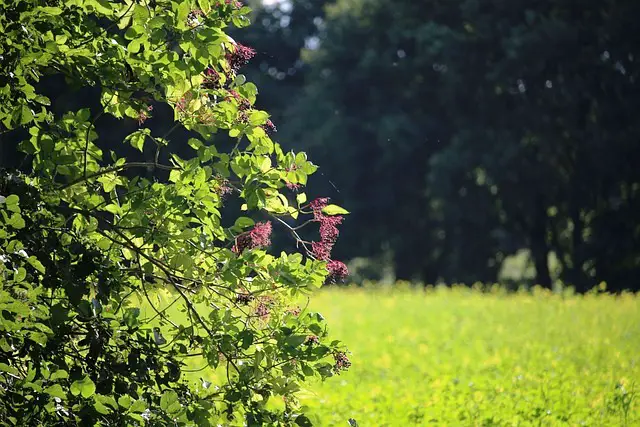
Most of us don’t think of the Elder as a tree but it is. It’s just a small tree and it’s most widely known for its elderberries. Elderberries are highly nutritious and also have significant medicinal properties.
One cup of elderberries contains a little over 100 calories, with 27 grams of carbs, one gram of fat, and one gram of protein. Even more impressive is that it boasts a hefty dose of antioxidants, a whopping 10 grams of dietary fiber, and 52 milligrams of vitamin C — 87 percent of your recommended daily intake.
Elderberry has for a long time been used in folk medicine as a diaphoretic, antipyretic and diuretic agent. In recent years it was also found to have antibacterial, antiviral antidepressant and anti-tumor and hypoglycemic properties, and to reduce body fat and lipid concentration.
17. Hawthorn Tree
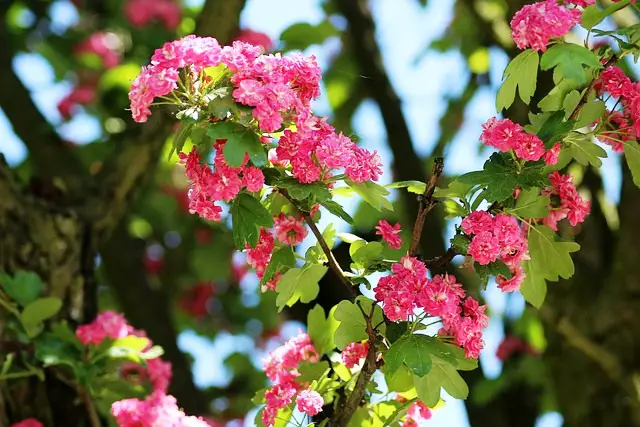
Hawthorn (Crataequs sp.) is prevalent in folk medicine and has been used to counteract high blood pressure, heart failure, and chest pain. Unlike many folk remedies, these effects have recently been substantiated by conventional medical research and marketing of hawthorn extract has followed.
A cardiac tonic was made from both the new, spring leaves and the fall berries to treat cardiovascular conditions. A standard caution was that prolonged use could lead to a drop in blood pressure.
It’s best if only used for a few weeks with a week off to avoid a sudden drop in blood pressure. Any use should also be avoided with any other heart medications.
The fruit often known as “haws” are a favorite of foragers and can be used to make jellies and jams. The young leaves are edible and are best in the spring. They have a nut-like taste and are usually used in salads.
18. Slippery Elm

The Slippery Elm is another one of those pharmacies in the forest. The list of medicinal benefits is long. Historically, a tincture of the inner bark was used to treat coughs, bronchitis and asthma. A study showed soothing effects for people with sore throats and laryngitis.
It is sometimes used to treat inflammation of the urinary tract including painful bladder syndrome. The same tincture serves as a diuretic.
Recent studies indicate that Slippery Elm tinctures relieve symptoms of Crohn’s disease or ulcerative colitis and irritable bowel syndrome.
The range of preparations include fine powders from the inner cambium bark layer for tinctures, a coarse powder from the inner bark for poultices and it’s also available commercially as both lozenges and capsules.
To make a tincture, pour 2 cups of boiling water over 2 tablespoons of the powdered inner bark and let steep for 5 minutes. To make the poultice for the skin, mix the coarser powder into boiling water until cool and apply externally to any affected areas.
Basic Food Preps for Parts of Trees
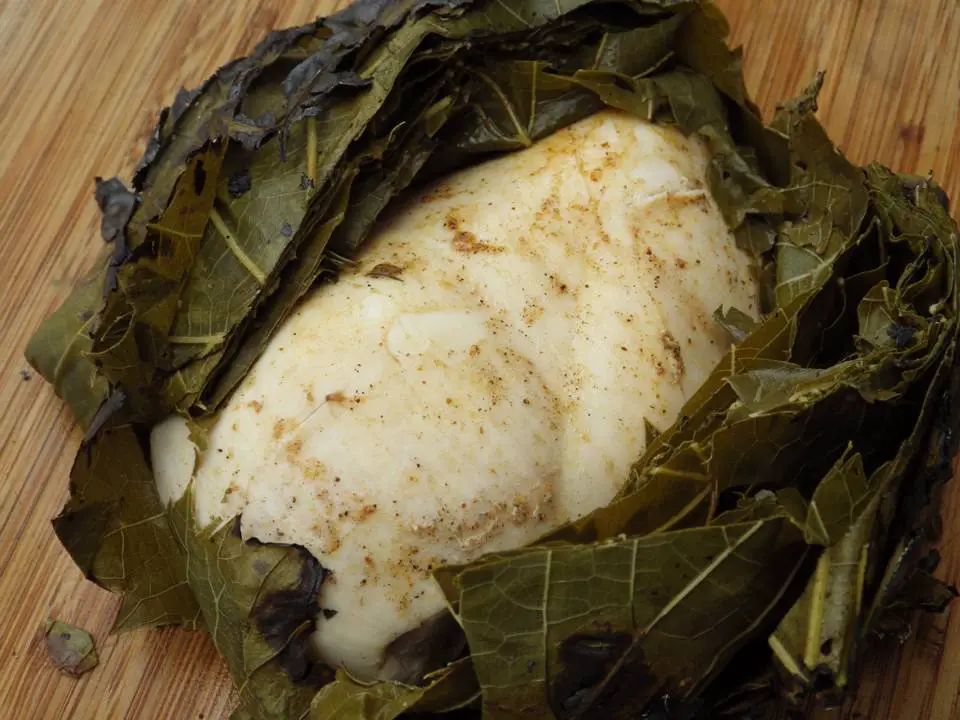
Here are some standard preparation processes used for both meals and medicinal purposes.
Leaves
Some leaves can be eaten raw in salads, tossed into soups, boiled and eaten as a side dish or dried for a tea or crushed into a powder for a poultice or mixed as an ointment or salve. Many cultures used leaves to wrap their food in place of pots and pans.
Bark
The inner cambium bark can be eaten raw, cooked and added to dishes, dried and ground into a flour or powder.
Nuts
Nuts can be roasted, ground into a flour or powder or added to dishes as an ingredient.
Fruits
Fruits can be eaten raw, cooked, canned, dried, dehydrated, juiced or jellied.
Roots
Roots are typically peeled, cooked or dried, ground into a flour or powder or chopped and added as an ingredient for dishes.
Basic Medicinal Preps for Parts of Trees
Decoctions (Teas)
Decoction as a process usually starts with some part of the tree (typically leaves, bark or roots) that is then dried and steeped in water.
Poultices
A poultice usually combines leaves or roots that are mashed while fresh or after boiling and then applied to the skin or body with a gauze or fabric covering.
Salves and Ointments
Salves and ointments often use beeswax or oils as a base and the parts of the tree (usually leaves, cambium bark or ground roots) are incorporated into the salve.
Powders
Flours and powders are essentially the same thing. It’s a substance that is dried and then pulverized into a powder either with a mill, grinder or food processor.
Caplets
Caplets are empty pills that you can fill with the herbal remedy of your choice. The herbal medicine is usually powdered and the caplets are filled by hand.
Tree Bonuses
There are some things that grow on trees that also offer nutritional and medicinal benefits. Here are few that you might come across while wild foraging trees.
Lichens

Blue green lichens have been eaten for centuries by ancient people around the world.
Mushrooms
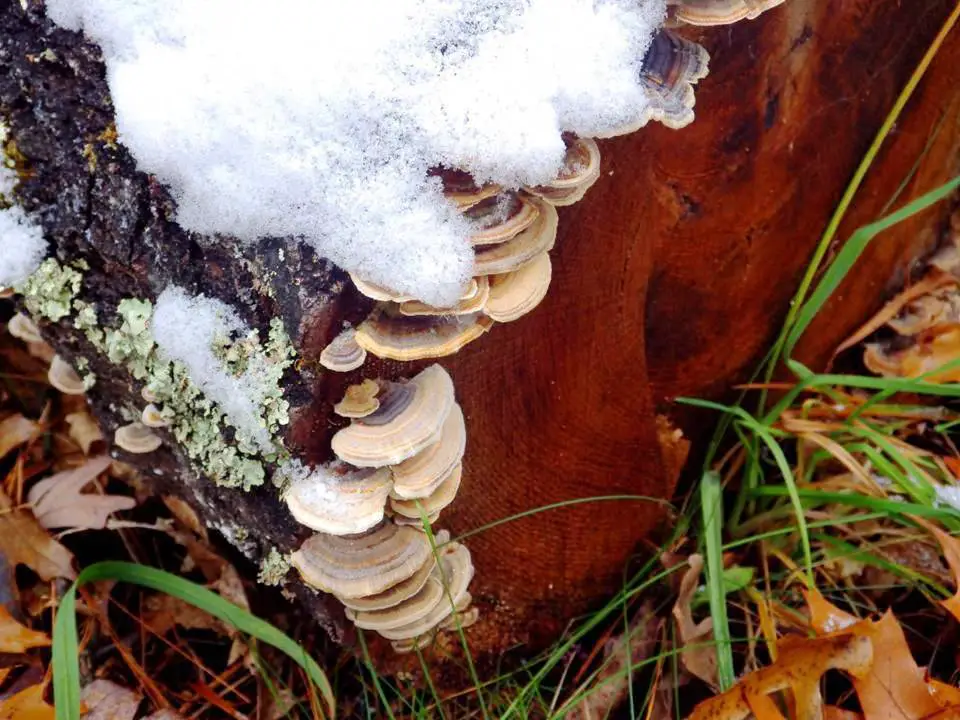
Shelf mushrooms are the most common mushrooms on trees but there are others that have both medicinal and nutritional value.
Moss

Moss commonly grows on trees and some varieties like Reindeer Moss have surprising medicinal properties. Although technically, Reindeer Moss is actually a lichen.
Resin
Tree resin emerges from gashes and gaps in many trees and has numerous survival uses.
And There’s More…
Trees can offer us natural shelter during a storm, wood for a fire, building materials for structures and shelters, basic materials for primitive tools and weapons, even fuel for torches and charcoal. That pretty much makes any tree valuable for survival. However…
…Be Careful Out There
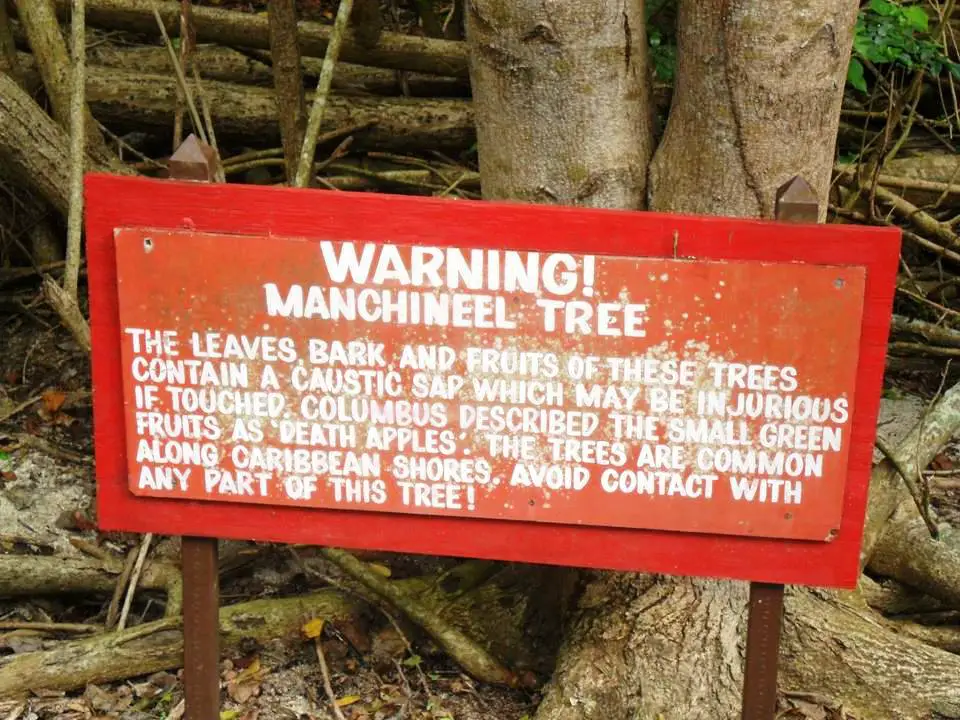
While you’re out and about munching on tree leaves and strips of bark it’s important to remember that not all trees are safe. In fact, some are deadly. Unfortunately, most of them won’t be accompanied by a convenient sign warning you about the dangers like this sign from an arboretum in Florida.
The reason so many plants present toxic characteristics is that plants have no choice. They’re rooted in the ground and can’t run away from predators. As a result, they have developed defense mechanisms over millions of years and while thorns are the most obvious, toxic chemicals and compounds are the most prevalent.
Here are some trees to simply avoid. There are more but if you come across one of these trees it’s best to move on.
Wild Cherry Tree
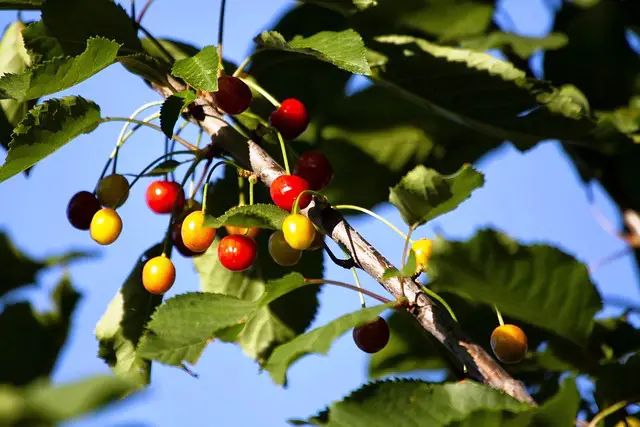
Poisonous wild cherry trees (Prunus serotina) are found throughout North America. Commonly called “black cherry” or “wild cherry,” the twigs and leaves of the trees are the source of the poison.
Castor Bean Tree
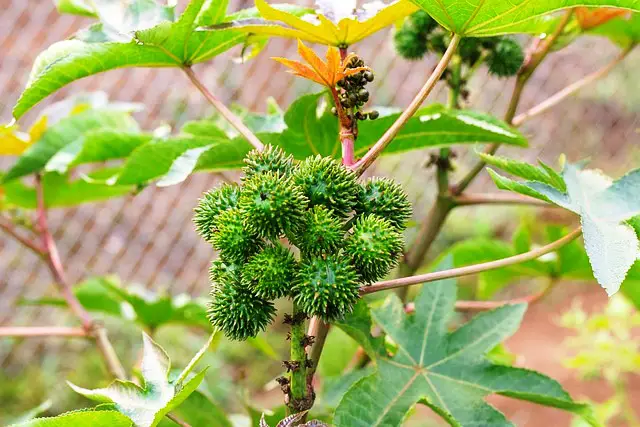
Castor bean trees are used to make castor oil. It has start-shaped leaves and grows along cultivated field edges and river banks. It originated from Africa, but you can now find it in North America and some parts of the southern and eastern U.S.
Castor oil is used for medicinal purposes, but only because the toxins are removed during processing. Eating a single castor bean with toxins in it is fatal. The castor bean contains ricin, a deadly and highly toxic chemical harmful to humans.
Cottonwood

Cottonwood is a large tree with weak wood and deep roots. The tree grows in lowland areas and along streams, allowing it to grow very fast. A cottonwood tree can grow up to 100 feet above the ground. While such a tree is a sight to behold, it is also potentially dangerous because of the weak wood. The tree is, therefore, quite dangerous
Remember the Trees
Beyond any preparations someone might make for a potential collapse is the value of knowledge and experience. Understanding and knowing how to find food and medical solutions from something as simple and apparent as a tree is valuable information.
Hopefully it’s not the only emergency resource we call upon in desperate times, but knowing how to combine it with other preparations and skills can make a tough time at least a little bit easier.
Like this post? Don't Forget to Pin It On Pinterest!









